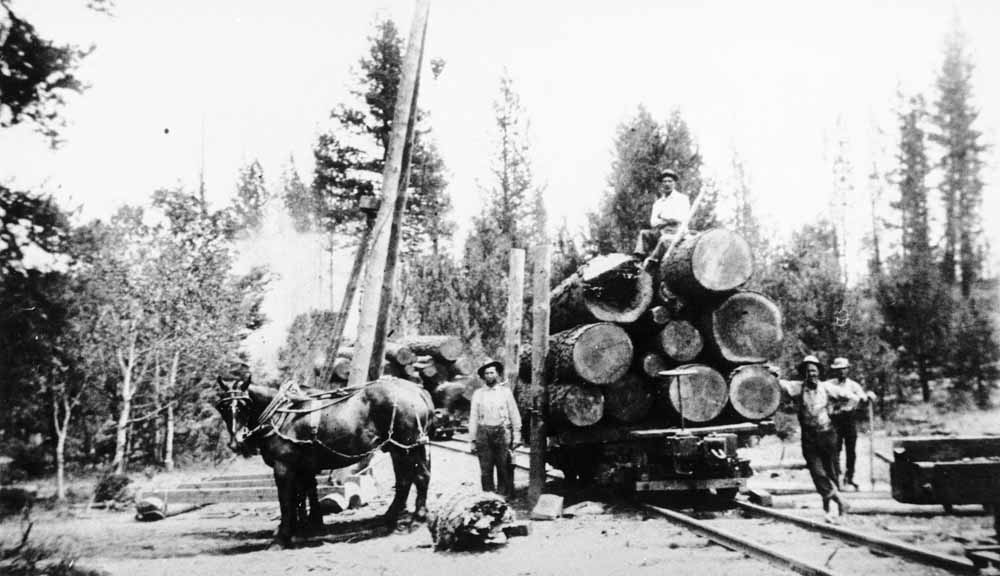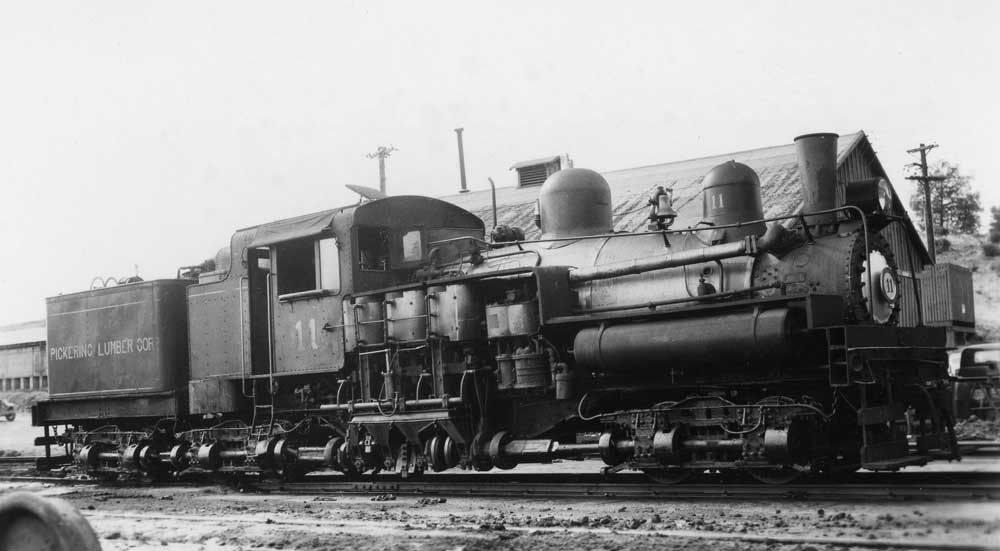|
Forest Lumber Company Modoc Lumber Company |
|
|
 |
|
Forest Lumber #4 leading a log train in the woods. The locomotive was exceptionally rare in two respects, specifically that is was of the exceedingly uncommon on logging
railroads 4-6-0 wheel arrangement and was a Lima built logging locomotive that wasn't a Shay. Clark Kinsey photograph, John T. Labbe Collection of Logging and Railroad Photographs, 1892-2010, Washington State Archives,
Digital Archives, http://www.digitalarchives.wa.gov.
|
|
|
|
History The story of one of the more interesting logging railroad operations in the Klamath country started in the early 1900s when a Wilbur Knapp built a small sawmill at Aspgrove, on the banks of the Williamson River a mile north of Chiloquin. Knapp sold the operation to J.O. Goldthwaite in 1918, who incorporated the Modoc Lumber Company to oversee the operation. Knapp, operating as the Williamson River Logging Company, shortly purchased two substantial units of Klamath Indian Reservation timber. The Modoc (Williamson) company immediately set itself apart from almost all other operations in the region when it started construction on a narrow gauge logging railroad running north out of Aspgrove, shortly renamed Pine Ridge. The railroad, powered by a single narrow gauge Heisler purchased from a mining operation in the California desert and using disconnected trucks, pushed north over the next several years along the west bank of the Williamson River. The narrow gauge railroad eventually stretched roughly fifteen miles north to Kirk, reached by 1923, where it wrapped around the north end of the end of the Southern Pacific line and started heading east. The narrow gauge crossed several of the other logging railroads radiating out of Kirk at grade. The arrival of the railroad to Kirk prompted the company to reconsider its operations, and in 1922 Modoc asked the Southern Pacific for a standard gauge connection at Kirk. The company shortly abandoned most of its narrow gauge trackage, converted what it still needed plus the Heisler to standard guage, and continued pushing the line east from Kirk as a now standard gauge railroad. SP handled the logs on their flatcars between Kirk and Pine Ridge. Unfortunately, the company experienced extreme financial difficulties at this time, and by early 1924 the company reorganized as the Modoc Pine Lumber Company. The new company did not operate anything in 1924, but by 1925 the Menifee Lumber Company controlled the enterprise and resumed operations. However, their revival was to be short lived, as a fire destroyed the sawmill on 4 May 1925. The Exchange Sawmill Sales Company of Kansas City stepped in and bought the operation shortly after the fire, which they incorporated as the Forest Lumber Company. Forest reopened the railroad immediately, hauling logs the company sold to other operations to raise cash, while it built a large new sawmill in Pine Ridge. A 1926 Directory of the Lumber Industry described the company's operations as follows: "Forest Lumber Co., Pine Ridge (successors to Modoc Pine Co., Appgrove); camp post office, Kirk; daily output, 150M; commissary; air compressors; 1 McGiffert loader; 6 logging tractors; 7 sets big wheels; 14 horses; route supplies via Kirk; camp telephone, Chiloquin; manager, F.T. Horan; superintendent, Fred Mulinax; purchasing agent, C.F. Coons; master mechanic, John Hill; 15 miles s.g. track; 50 lb. rail; 1 rod locomotive; 2 geared locomotives; 2 moving cars; maximum grade, 2 per cent; locomotive fuel, oil; trucks and flat cars supplied by the Southern Pacific railroad." The company completed the sawmill by the end of 1925. Operations on the line out of Kirk lasted until 1936, when the timber ran out. Forest then broke ground on a new railroad running east from the SP main line at Mazama into a tract of reservation timber that had been previously sold to the Shevlin-Hixon Lumber Company from Bend but then conveyed to Forest. The end for the Forest operation came quickly, as on 19 August 1939 a fire broke out in the lumberyard. The flames quickly spread, destroying the sawmill and the town of Pine Ridge before spreading west into the surrounding timberlands. Forest quickly decided not to rebuild the mill, and by the following year the company had sold the Mazama railroad to Chiloquin Lumber, scrapped out the remaining logging railroad running out of Kirk, and sold off all remaining equipment. |
|
|
Maps |
|
Map of the Modoc and Forest Lumber Companies logging railroad system.
|
 |
|
The Mazama operation Forest Lumber Company sold to Chiloquin Lumber in 1939.
|
|
|
|
Locomotive Roster 1- Stearns Heisler 2-truck, c/n 1018, Built 1898. Drivers 33", Weight 25 tons. Built as Pacific Coast Borate Company #1, Daggett, CA (narrow gauge); to Daggett & Borate Railroad, named Marion; to Modoc Lumber Company/Williamson River Logging Company; converted to standard gauge circa 1922; to L.B. Menefee Lumber; to Forest Lumber Company. 2- Heisler 2-truck, c/n 1189, Built 1910. Weight 60 tons. Built as Johnson-Dean Lumber Company #101, Robe, WA; to Modoc Lumber Company/Williamson River Logging #2; to L.B. Meneffee Lumber Company; to Forest Lumber Company. Wrecked and scrapped at Calimus Camp, date unknown. 3- No information. 4- Lima 4-6-0, c/n 1034, Built 1906. Cyliners 7x24; Drivers 48"; Tractive Effort 22,100 lbs., Weight 53 tons. Built as Horseshoe Lumber Company #4, River Falls, AL; to Forest Lumber Company #4, Pine Ridge, OR; to Lamm Lumber Company #4. Scrapped June 1947. 5- Lima "Pacific Coast" 3-Truck Shay, c/n 3327, Built 1929. Cyliners 13x15, Drivers 36", Weight 90 tons. Purchased new; to Pickering Lumber Corporation #11:2 1941; to private party 1965; to Klamath & Hoppow Valley #11, Klamath, California, 1968, but never delivered to property; to Mt. Rainier Scenic Railroad, Elbe, WA; to Mt. Rainier Railroad and Logging Museum. Currently stored out of service on Mt. Rainier Railroad. |
|
|
|
Photos |
 |
|
Modoc Lumber/Williamson Logging #1 with a log train. John T. Labbe Collection of Logging and Railroad Photographs, 1892-2010, Washington State Archives,
Digital Archives, http://www.digitalarchives.wa.gov.
|
 |
|
Loading logs at a Modoc Lumber/Williamson Logging #1 landing. John T. Labbe Collection of Logging and Railroad Photographs, 1892-2010, Washington State Archives,
Digital Archives, http://www.digitalarchives.wa.gov.
|
 |
|
One of the two McGiffert loaders Forest Lumber owned loading Great Northern log flats. John T. Labbe Collection of Logging and Railroad Photographs, 1892-2010, Washington State Archives,
Digital Archives, http://www.digitalarchives.wa.gov..
|
 |
|
The former Forest Lumber #4, now the property of Lamm Lumber, sitting derelict at Modoc Point. Ivan W. Saunders photo.
|
 |
|
The former Forest Lumber #5 as Pickering Lumber Corp #11 in Standard, California.
|
|
|